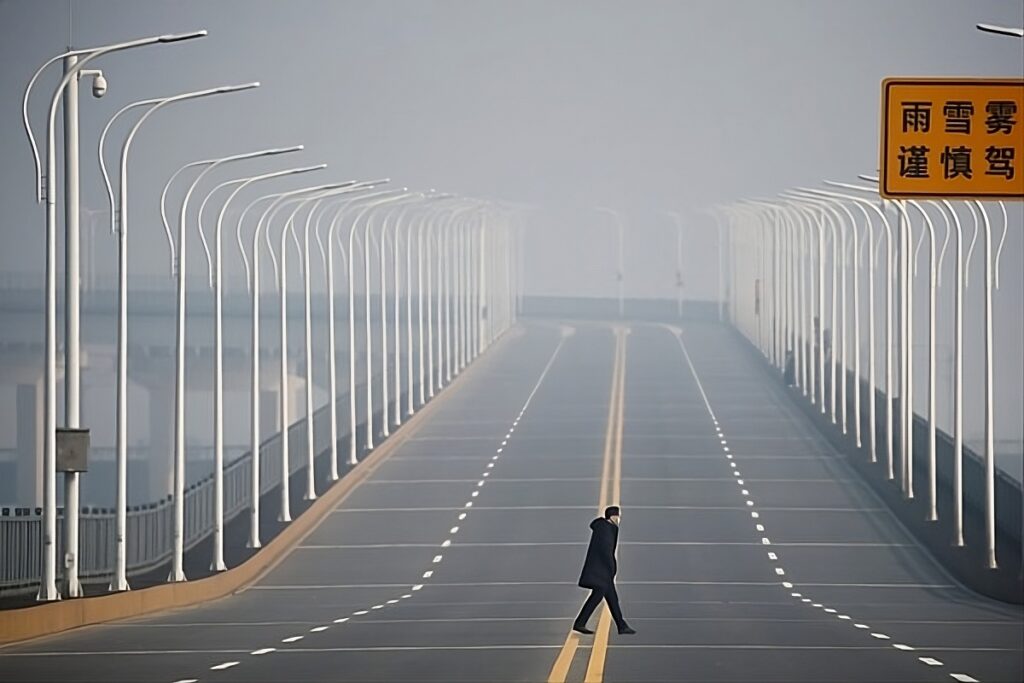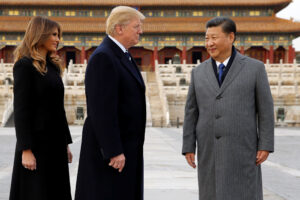In the gleaming metropolises of Beijing and Shenzhen, where skyscrapers pierce the clouds and drones buzz through the air, China projects an image of unstoppable progress—a high-tech utopia powered by innovation and ambition. The Chinese Communist Party (CCP) would have you believe this is the full story: a nation of gleaming cities, cutting-edge green tech, and a “high-trust society” where prosperity reigns. But beneath this carefully curated facade, a far grimmer reality festers. You get the sense that something’s deeply wrong when you see viral clips of desperate workers kneeling on highways, unpaid for months, or young graduates with advanced degrees collapsing under the weight of unfulfilled dreams. China’s economy is fraying, and the human toll is staggering.
The CCP’s propaganda machine works overtime to paint a picture of stability and success, but the cracks are impossible to ignore. Take Chongqing, a sprawling urban hub often celebrated as a symbol of China’s rapid development. Here, college graduates—many with master’s degrees—scramble for jobs paying as little as $200 a month. That’s not a typo. In a country where the cost of living in major cities rivals Western capitals, these wages are a cruel joke. Construction workers, delivery drivers, and even white-collar professionals are caught in a vise: unpaid wages, no legal recourse, and a job market so saturated that employers can replace you faster than you can protest. What’s troubling is how this economic despair cuts across every stratum of society, from rural laborers to urban elites.
The absence of labor protections in China exacerbates this crisis. Unlike in Western democracies, where unions or courts might offer some recourse, Chinese workers have nowhere to turn. The rule of law is a mirage; labor laws, if they exist, are rarely enforced. If you’re a worker owed a year’s wages—say, $2,400 in a good year—your options are bleak. Threaten to quit, and your boss will laugh, knowing a dozen others are waiting to take your place. Go to court, and you’ll find the system stacked against you. This isn’t just a policy failure; it’s a deliberate feature of a system that prioritizes control over fairness. The CCP’s grip on power depends on keeping dissent in check, and that includes silencing the cries of unpaid workers.
Consider the young man on a Shenzhen subway, captured in a recent viral video, screaming in anguish over a lowball job offer he had no choice but to accept. He’s not an outlier. Youth unemployment in China is soaring—officially reported at over 15% but likely much higher, given the government’s habit of massaging data. For a generation raised on promises of upward mobility, the reality is a gut punch. You study engineering or mathematics, graduate with top marks, and end up delivering noodles for $3 an order. It’s not just a hit to your wallet; it’s a blow to your dignity. These young people aren’t just struggling to pay rent—they’re wrestling with the crushing realization that the system they trusted has betrayed them.
This economic malaise has historical echoes. In the 1980s, China’s opening to the world sparked a wave of optimism, lifting millions out of poverty and fueling decades of growth. But that era is over. The property bubble, exemplified by the collapse of giants like Evergrande, has gutted the construction sector, once a cornerstone of China’s economy. Local governments, drowning in debt, can’t fund infrastructure projects, leaving workers unpaid. Meanwhile, global demand for Chinese exports has slumped, and the CCP’s zero-COVID policies—though now abandoned—left scars on small businesses and supply chains. The result is a vicious cycle: declining growth, rising unemployment, and a government more focused on saving face than saving its people.
The human stories are what make this crisis so visceral. In Shenzhen, once a beacon of China’s economic miracle, workers cram into squalid, makeshift dormitories, their dreams of prosperity replaced by survival. Elderly vendors huddle in the rain, selling vegetables to scrape by, while others, like a 70-year-old grandfather caring for three grandchildren, face poverty without a safety net. China’s lack of social welfare programs—ironic for a state that calls itself communist—leaves these vulnerable populations to fend for themselves. Homelessness, though hidden from official narratives, is rampant. Petty crime, like stealing hot dogs or durians from markets, is surging as desperation grows. Frankly, it’s heartbreaking to see a society unravel like this, especially when the CCP claims to have eradicated poverty.
Then there’s the delivery driver phenomenon. The CCP has tried to spin these workers as heroes of the new economy, a noble career path for a modern China. But the reality is far less glamorous. These drivers, many with advanced degrees, work grueling hours for meager pay, often collapsing from exhaustion on the side of the road. A recent clip showed one such driver, slumped against his scooter, defeated by a system that demands everything and gives nothing back. It’s a stark reminder that propaganda can’t mask reality forever. The CCP’s attempt to glorify these jobs feels like a cruel deflection from the truth: there simply aren’t enough good jobs to go around.
What’s infuriating is how the CCP and its defenders dismiss these struggles. Post a video of a Chinese grandmother digging through trash on social media, and you’ll be met with whataboutism: “What about America’s homeless problem?” or “Have you seen Kensington Avenue?” This tactic isn’t just lazy—it’s dehumanizing. It reduces Chinese suffering to a geopolitical point-scoring game, as if the pain of a Chongqing graduate or a Shenzhen laborer doesn’t matter unless it can be weaponized against the West. These deflections, often amplified by Western influencers aligned with CCP narratives, betray a callous disregard for the very people they claim to champion. The irony is that this whataboutism reveals more about the defenders’ priorities than the problems they’re dodging.
The CCP’s obsession with image over substance is at the heart of this crisis. Losing face is anathema to the regime, which is why it suppresses dissent and polishes its propaganda to a high sheen. But the truth is leaking out, one viral clip at a time. Raising awareness isn’t just about exposing China’s problems—it’s about holding a mirror to a government that would rather let its people suffer than admit failure. The hope is that international scrutiny might force change, even if only to save face. History shows that the CCP responds to pressure, not pleas. The Tiananmen Square protests of 1989, though brutally crushed, led to economic reforms in the 1990s. Perhaps today’s desperation could spark similar shifts—if the world keeps watching.
In the end, China’s crisis is a human one. It’s about the delivery driver who can’t afford dinner, the graduate who can’t pay rent, the grandfather who can’t feed his grandkids. These aren’t statistics—they’re people, trapped in a system that prioritizes power over progress. The shiny cities and high-speed trains are real, but so are the slums and the despair. If China is to become the utopia it claims to be, it must start by acknowledging the suffering it’s worked so hard to hide. Until then, the world should keep asking: at what cost does this “miracle” come?



